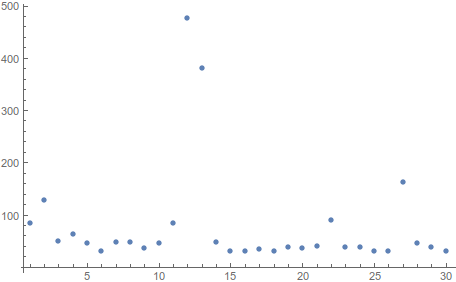Hi Andreas,
this is an interesting problem and I would like to see a definitive answer as well!
One gets an idea about the nature of the problem by playing around. You can start with searching for pairwise conflicts:
pIndexList2 = Select[Tuples[Range[Length[eqs]], 2], First[#] < Last[#] &];
comb2 = Select[{{#1, #2}, FullSimplify[eqs[[#1]] && eqs[[#2]]]} & @@@ pIndexList2, ! #[[2]] &]
(* Out: {{{12,13},False}} *)
In the same manner one can find conflicting triples:
pIndexList3 = Select[Tuples[Range[Length[eqs]], 3], #[[1]] < #[[2]] < #[[3]] &];
comb3 = Select[{{#1, #2, #3}, FullSimplify[eqs[[#1]] && eqs[[#2]] && eqs[[#3]]]} & @@@ pIndexList3, ! #[[2]] &];
comb3 /. {{___, 12, 13, ___}, _} -> Nothing (* new combinations only *)
(* Out: {{{1,2,27},False},{{1,12,27},False},{{2,11,27},False},{{11,12,27},False}} *)
or quadruples:
pIndexList4 = Select[Tuples[Range[Length[eqs]], 4], #[[1]] < #[[2]] < #[[3]] < #[[4]] &];
comb4 = Select[{{#1, #2, #3, #4}, FullSimplify[eqs[[#1]] && eqs[[#2]] && eqs[[#3]] && eqs[[#4]]]} & @@@
pIndexList4, ! #[[2]] &];
falseCombsPattern = {#, _} & /@ {{___, 12, 13, ___}, {1, 2, ___, 27, ___}, {1, ___, 12, ___, 27, ___}, {___, 2, ___, 11, ___, 27, ___}, {___, 11, 12, ___, 27, ___}};
comb4 /. Thread[falseCombsPattern -> Nothing] (* new combinations only *)
For me the interesting point seems to become obvious by making a statistics of the indices of all quadruples:
ListPlot[Tally@Flatten[First /@ comb4], PlotRange -> All]
giving:

So my guess is that the most conflicting equations are always the ones which gives a pairwise conflict (eqn12 and eqn13 in this case), because they show up in all other combinations as well. Then in this ranking comes eqn27 and then eqn2. Does that make sense to you?
Regards -- Henrik